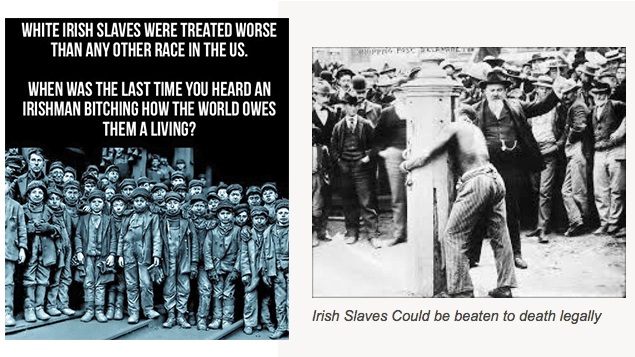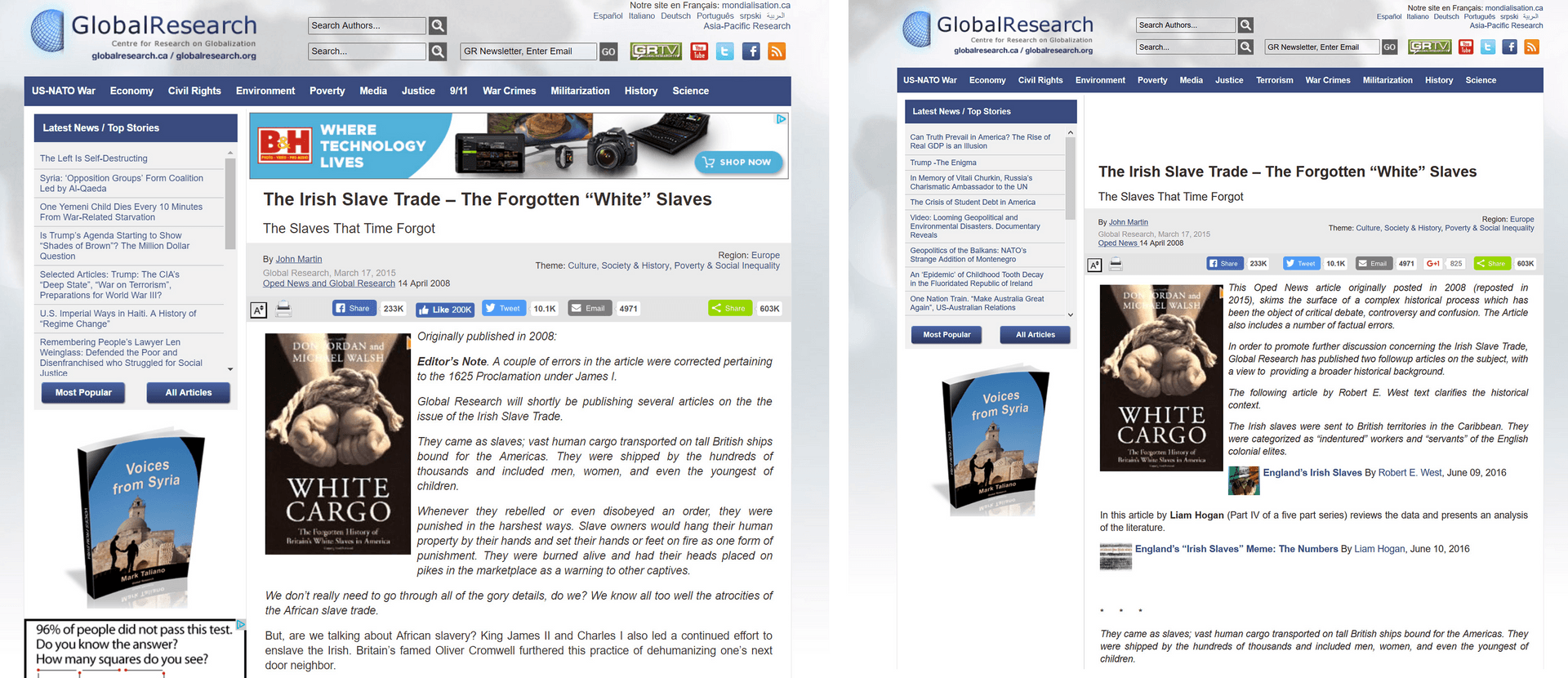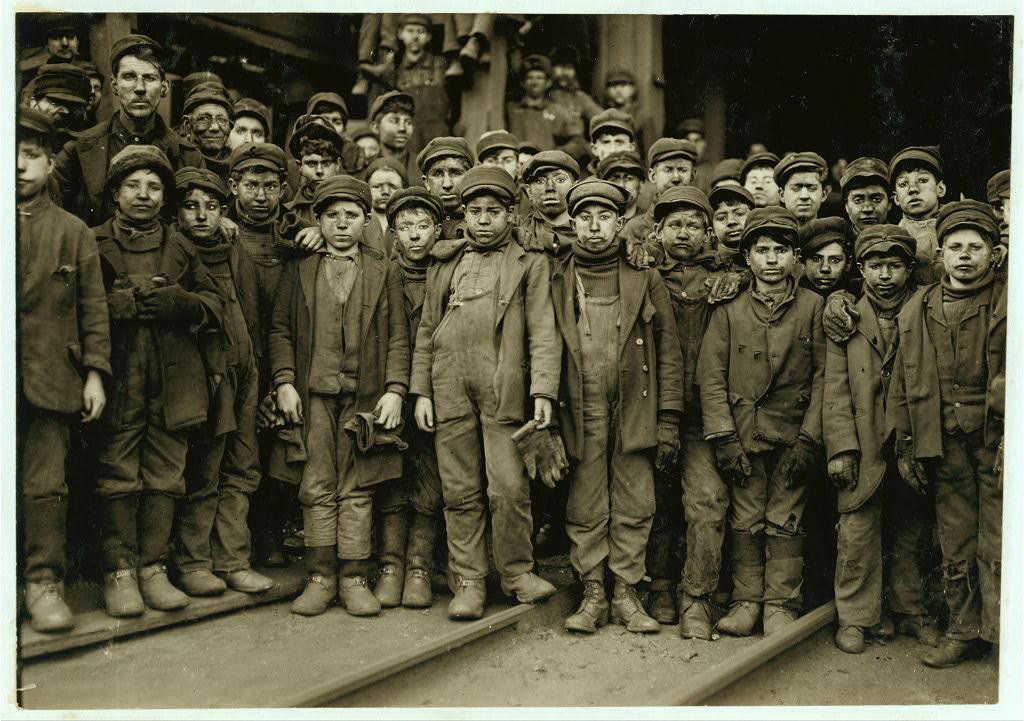Breaker boys, who broke up pieces of coal, worked in Ewen Breaker of Pennsylvania Coal Co. in 1911. This image has been used and mislabeled in campaigns to perpetuate a myth about “Irish slaves” being brought to the US.
Irish Americans were slaves once too — or so a historically inaccurate and dangerously misleading internet meme would have you believe.
The meme comes in many varieties but the basic formula is this: old photos, paintings and engravings from all over the world are combined with text suggesting they are historic images of forgotten “Irish slaves.”
The myth underlying the meme holds that the Irish — not Africans — were the first American slaves. It rests on the idea that 17th century American indentured servitude was essentially an extension of the transatlantic slave trade.
Popular among racists, white supremacists, neo-Nazis, white nationalists and neo-confederate groups, the “Irish slave” trope is often accompanied by statements to the effect of, “Our ancestors suffered and we got over it, why can’t you?” According to Liam Hogan — a librarian and scholar who has tracked the myth — references to these “Irish slaves” are used to derail conversations about racism and inequity.
“The principle aim of this propaganda, which aligns with that of the international far-right, is to empty the history of the transatlantic slave trade of its racial element,” says Hogan.
The meme has become increasingly visible since 2013. Its trajectory has paralleled the rise of Black Lives Matter and has even used that movement’s language with graphics, t-shirts and Facebook groups that proclaim, “Irish Lives Matter.”
In a six-part series on Medium, Hogan deconstructs the images and claims that have fueled the meme. That picture of “Irish slave” children? That’s actually a photo of young coal mine workers in Pennsylvania in 1911. The one of the “Irish” man being beaten to death in front of a crowd in the 1800s? That’s really a black man tied to a whipping post and being tortured in the 1920s.

While there is a growing awareness that these arguments are based on misinformation, the fiction is now seen by many as fact thanks to a strange web of mutually reinforcing lies. The lies have also taken on a life beyond the internet.
At a Confederate flag rally in Mississippi in July 2015 one protester told a reporter, “There were more white Irish slaves then there were blacks. And the Irish slaves were treated a lot worse than the black slaves.”
Those who traffic in this lie minimize and ignore the realities that made slavery distinct from other forms of servitude in the British colonies. African slaves were considered property; Irish indentured servants were not. And though they faced inhumane working conditions, Irish indentured servants could typically decide if they wanted to enter into their labor contracts. Unlike the Africans forced to come to the US as slaves, the servitude of Irish people in the US did not span their entire lifetimes, and did not bind their children to a life of servitude.
The Irish-as-slaves meme has a curious anatomy that Hogan has traced back to self-published books, family genealogy blogs and white supremacist news sites. He attributes much of the misinformation behind the meme to an article published by the Centre for Research on Globalization, a Canadian-based organization that touts its focus on education and humanitarianism. Hogan says that their frequently referenced 2008 article, “The Irish Slave Trade — The Forgotten ‘White’ Slaves,” has an outsized impact but “does not contain a single historically accurate claim or sentence.”
Even so, the article has been cited by mainstream news sites like Scientific American, Irish Examiner and Irish Central. In response, more than 80 scholars and supporters have signed an open letter debunking the Global Research article and asking the media to stop their practice of uncritically citing it and related sources. Scientific American responded by heavily revising their story on the topic and the Irish Examiner removed theirs altogether. But Irish Central has made no such revisions and did not respond to a request to comment for this story.

The editor of Global Research, Michel Chossudovsky, defends their decision to keep the story on their website. He wrote in an email that it was, “originally published by OpEd News, we do not necessarily endorse it, we have also published critiques of that article by several historians with a view to promoting debate.”
Shortly after he replied to PRI’s questions, the article was updated with a lengthy editorial note and links to the articles that “promote debate” on the basis of long-since discredited claims.
The Global Research article is illustrated by the cover of a book, “White Cargo: The Forgotten History of Britain’s White Slaves in America,” which was published by NYU Press in 2008. The book’s cover, dramatically illustrated with two white fists bound by rope manacles, often appears alongside articles that perpetuate the “Irish slave” myth.
The authors of the book are British filmmakers Don Jordan and Michael Walsh, who argue that slavery is more a feeling than a system. “Slavery,” they claim, “is not defined by time but by the experience of the subject.”
Scholars discredit this assessment. In a review in “The Historian,” Dr. Dixie Ray Haggard says the book uses sound primary sources to draw conclusions that are plagued by “fatal flaws.” The most egregious, he writes, is that it “deliberately conflates indentured servitude with slavery. … Rather than explore the complexity of labor and social relations in colonial America and increase our understanding of these institutions, these authors chose to oversimplify and confuse.”
Still, the book was reviewed favorably in mainstream news outlets including The New York Times, Publishers Weekly and The New York Review of Books. Co-author Walsh qualified his claims in an interview with NPR that “We’re not saying the Whites ever suffered quite as much as the worst treated Blacks.” Yet the book helped popularize the idea that Irish indentured servants had it just as bad, if not worse, than African slaves.
This “Irish slave” narrative is the latest in a long history of Irish Americans affirming their own group identity at the expense of black people. In his book, “How the Irish Became White,” Noel Ignatiev shows how in 19th century America, when racial identities had as much to do with national origin as skin color, Irish immigrants strove to be socially classed as white. In order to achieve this status and the privileges that came with it, they routinely and deliberately differentiated themselves from black people by — at times violently — forcing them into an even lower ranking in the American social order.
They sought to minimize the horrors of slavery then too. Irish workers in antebellum America self-identified as “wage slaves,” claiming they had it far worse than actual slaves because they weren’t entitled to “benefits” like the material comfort and the assurance of work they said slaves enjoyed.
Decades later in 1921, W.E.B. Du Bois wrote that Irish anti-blackness has been expressed so “continuously and emphatically” that “there can be no doubt of the hostility of a large proportion of Irish Americans toward Negroes.”
Now, as the “Irish slave” myth festers online and beyond, there is no visibly Irish American movement to answer it. There is no Irish American equivalent to Asians for Black Lives. Irish Americans participate in movements for the rights of African Americans, but they do not announce their heritage as loudly as do proponents of the “Irish slave” myth.
Leaders within the Catholic church, which has historically served as the moral compass for many Irish Americans, are beginning to grapple with this legacy of anti-blackness. Dr. Kevin Considine, professor of theology at Calumet College of St. Joseph, called for direct responses to “implicit, insidious racism” in an essay for US Catholic last summer.
“Do black lives matter to white Catholics? If so, we need to do more than say the right words,” he wrote.
